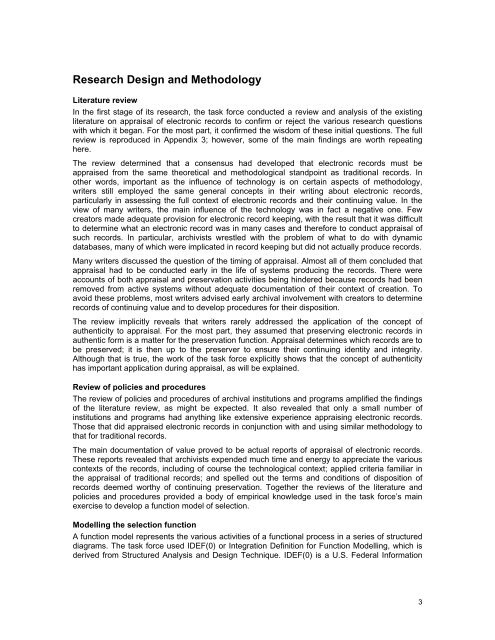Appraisal Task Force Report - The InterPARES Project
Appraisal Task Force Report - The InterPARES Project
Appraisal Task Force Report - The InterPARES Project
Create successful ePaper yourself
Turn your PDF publications into a flip-book with our unique Google optimized e-Paper software.
Research Design and Methodology<br />
Literature review<br />
In the first stage of its research, the task force conducted a review and analysis of the existing<br />
literature on appraisal of electronic records to confirm or reject the various research questions<br />
with which it began. For the most part, it confirmed the wisdom of these initial questions. <strong>The</strong> full<br />
review is reproduced in Appendix 3; however, some of the main findings are worth repeating<br />
here.<br />
<strong>The</strong> review determined that a consensus had developed that electronic records must be<br />
appraised from the same theoretical and methodological standpoint as traditional records. In<br />
other words, important as the influence of technology is on certain aspects of methodology,<br />
writers still employed the same general concepts in their writing about electronic records,<br />
particularly in assessing the full context of electronic records and their continuing value. In the<br />
view of many writers, the main influence of the technology was in fact a negative one. Few<br />
creators made adequate provision for electronic record keeping, with the result that it was difficult<br />
to determine what an electronic record was in many cases and therefore to conduct appraisal of<br />
such records. In particular, archivists wrestled with the problem of what to do with dynamic<br />
databases, many of which were implicated in record keeping but did not actually produce records.<br />
Many writers discussed the question of the timing of appraisal. Almost all of them concluded that<br />
appraisal had to be conducted early in the life of systems producing the records. <strong>The</strong>re were<br />
accounts of both appraisal and preservation activities being hindered because records had been<br />
removed from active systems without adequate documentation of their context of creation. To<br />
avoid these problems, most writers advised early archival involvement with creators to determine<br />
records of continuing value and to develop procedures for their disposition.<br />
<strong>The</strong> review implicitly reveals that writers rarely addressed the application of the concept of<br />
authenticity to appraisal. For the most part, they assumed that preserving electronic records in<br />
authentic form is a matter for the preservation function. <strong>Appraisal</strong> determines which records are to<br />
be preserved; it is then up to the preserver to ensure their continuing identity and integrity.<br />
Although that is true, the work of the task force explicitly shows that the concept of authenticity<br />
has important application during appraisal, as will be explained.<br />
Review of policies and procedures<br />
<strong>The</strong> review of policies and procedures of archival institutions and programs amplified the findings<br />
of the literature review, as might be expected. It also revealed that only a small number of<br />
institutions and programs had anything like extensive experience appraising electronic records.<br />
Those that did appraised electronic records in conjunction with and using similar methodology to<br />
that for traditional records.<br />
<strong>The</strong> main documentation of value proved to be actual reports of appraisal of electronic records.<br />
<strong>The</strong>se reports revealed that archivists expended much time and energy to appreciate the various<br />
contexts of the records, including of course the technological context; applied criteria familiar in<br />
the appraisal of traditional records; and spelled out the terms and conditions of disposition of<br />
records deemed worthy of continuing preservation. Together the reviews of the literature and<br />
policies and procedures provided a body of empirical knowledge used in the task force’s main<br />
exercise to develop a function model of selection.<br />
Modelling the selection function<br />
A function model represents the various activities of a functional process in a series of structured<br />
diagrams. <strong>The</strong> task force used IDEF(0) or Integration Definition for Function Modelling, which is<br />
derived from Structured Analysis and Design Technique. IDEF(0) is a U.S. Federal Information<br />
3


